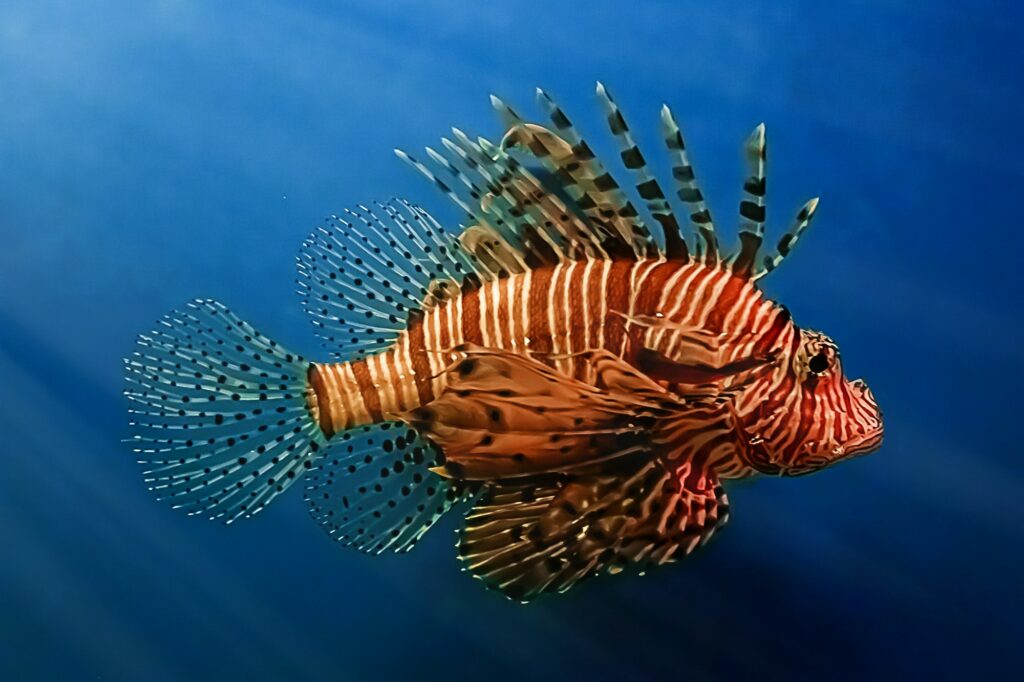The pictures we use in our articles might not show exactly what the words say. We choose these pictures to make you interested in reading more. The pictures work together with the words but don’t take their place. The words still tell you the important facts.
The Zebra Lionfish, scientifically known as Dendrochirus zebra, is a mesmerizing creature that has captured the imagination of marine enthusiasts and researchers alike. With its striking appearance and unique characteristics, this fascinating species offers a window into the complex world of marine ecosystems. In this comprehensive exploration, we'll dive deep into 20 captivating facts about the Zebra Lionfish, shedding light on its behavior, habitat, and ecological significance.
1. A Name with Many Faces
The Zebra Lionfish, also known as the zebra turkeyfish, boasts a variety of names that reflect its distinctive appearance and the diverse cultures that have encountered it. This multitude of monikers speaks to the species' widespread impact on human imagination and marine ecosystems alike.
2. Unmistakable Stripes
True to its name, the Zebra Lionfish sports eye-catching vertical stripes in a mesmerizing combination of orange, white, and black. This bold pattern serves a dual purpose:
- Warning Coloration: The striking stripes act as a natural warning sign to potential predators, signaling the fish's venomous nature.
- Camouflage: Surprisingly, these bold markings also help the lionfish blend in with the complex patterns of coral reefs, allowing it to ambush prey more effectively.

3. Venomous Defender
One of the most notable features of the Zebra Lionfish is its array of 13 venomous spines along its back. These spines are not just for show – they're a potent defense mechanism that can deliver a painful sting to potential predators or unwary divers. The venom contains acetylcholine and a neurotoxin that can cause:
- Intense pain
- Swelling
- Numbness
- In rare cases, more severe symptoms
Divers and marine enthusiasts must maintain a safe distance from these beautiful but potentially dangerous creatures.
4. Widespread Wanderer
The Zebra Lionfish has a vast natural range, inhabiting the tropical waters of the Indo-West Pacific. Its distribution spans:
- The Red Sea
- The Indian Ocean
- The western and central Pacific Ocean
- From southern Japan to southern Australia and eastward to the islands of the western Pacific
This extensive range demonstrates the species' adaptability to various marine environments and its ecological significance across a wide geographical area.
5. Deep Dweller
While often spotted in shallow reefs, the Zebra Lionfish displays remarkable depth adaptability. They can be found:
- In shallow reef flats
- In lagoons
- On outer reef slopes
- At depths of up to 80 meters (262 feet)
This versatility allows the species to thrive in a variety of underwater landscapes, from vibrant coral gardens to dimly lit caves and crevices.
6. Impressive Size
Despite its delicate appearance, the Zebra Lionfish can grow to a respectable size. Some key points about its dimensions include:
- Maximum length: Up to 25 centimeters (10 inches)
- Average adult size: 15-20 centimeters (6-8 inches)
- Weight: Can reach up to 500 grams (1.1 pounds)
These dimensions make the Zebra Lionfish a substantial presence in its ecosystem, capable of consuming a variety of prey items and playing a significant role in the food web.
7. Slow and Steady
Unlike many fast-swimming fish, the Zebra Lionfish is known for its slow, deliberate movements. This unhurried pace contributes to:
- Energy conservation in its coral reef habitat
- Improved hunting efficiency through stealth
- A peaceful demeanor that belies its venomous nature
However, when necessary, these fish can move with surprising speed to capture prey or evade threats.
8. Hidden Hunter
The Zebra Lionfish has a penchant for seeking out shadowy spots. This behavior serves multiple purposes:
- Protection: Hiding in crevices and under ledges provides shelter from larger predators.
- Hunting Strategy: Concealment allows the lionfish to ambush unsuspecting prey more effectively.
- Energy Conservation: Resting in shaded areas helps the fish conserve energy between hunting forays.
9. Immune to Its Own Venom
In an interesting twist of nature, all lionfish, including the Zebra Lionfish, are immune to each other's venom. This unique adaptation:
- Allows them to coexist without the risk of accidental stings from their own species
- May play a role in their mating behavior, enabling closer contact during courtship
- Could potentially lead to medical research on venom resistance
10. Unexpected Social Butterflies
While initially described as solitary predators, recent observations have revealed a more social side to the Zebra Lionfish. Researchers have noted:
- Small groups of two to three individuals living together
- Cooperative hunting behaviors
- Potential communication through fin displays and body postures
This social behavior challenges previous assumptions about lionfish and opens up new avenues for research into their complex interactions.
11. Cooperative Hunters
When hunting in groups, Zebra Lionfish display remarkable coordination. Their hunting strategy includes:
- Using their fins and venomous spines to herd prey into confined areas
- Taking turns to strike at cornered prey
- Employing jets of water to disorient and manipulate their targets
This level of cooperation is relatively rare among fish species and highlights the sophisticated behavior of the Zebra Lionfish.
12. Fancy Fins
The Zebra Lionfish boasts large, fan-like pectoral fins that are as functional as they are beautiful. These fins serve multiple purposes:
- Locomotion: The fins help the fish maneuver precisely in complex reef environments.
- Hunting: They're used to corner and trap prey during hunting.
- Communication: Fin displays play a role in social interactions and potential mating rituals.
- Defense: The spread fins make the fish appear larger to potential predators.
13. Diverse Diet
These predators have a varied palate, feeding on a wide range of marine life. Their diet typically includes:
- Small fish
- Shrimp and other crustaceans
- Mollusks
- Occasionally, smaller lionfish
This diverse diet contributes to their success in various marine ecosystems and highlights their role as opportunistic predators.
14. Natural Predators
Despite their venomous defenses, Zebra Lionfish are not without predators. Some known predators include:
- Large groupers
- Sharks
- Moray eels
These predators have developed strategies to avoid the lionfish's venomous spines, showcasing the ongoing evolutionary arms race in marine ecosystems.
15. Reproductive Prowess
Zebra Lionfish exhibit fascinating reproductive behaviors:
- They are gonochoristic, meaning individuals are either male or female throughout their lives.
- Mating involves elaborate courtship rituals, including fin displays and synchronized swimming.
- Females can release up to 15,000 eggs per spawning event, which are fertilized externally.
- Spawning often occurs around the full moon, with eggs hatching within 36 hours.
16. Larval Journey
The early life stages of the Zebra Lionfish are characterized by a pelagic larval phase:
- Larvae drift in ocean currents for about 25-40 days.
- During this time, they develop their distinctive features, including venomous spines.
- This planktonic stage allows for wide dispersal, contributing to the species' broad geographic range.
17. Ecological Impact
While beautiful, the Zebra Lionfish can have significant ecological impacts, especially when introduced to non-native habitats:
- They are efficient predators that can quickly deplete local fish populations.
- Their presence can disrupt the balance of coral reef ecosystems.
- In areas where they are invasive, they have few natural predators, leading to rapid population growth.
18. Conservation Considerations
Understanding and managing Zebra Lionfish populations is crucial for marine conservation:
- In their native range, they are part of a balanced ecosystem.
- In introduced areas, like the Caribbean, efforts are made to control their populations through targeted fishing and removal programs.
- Research into their biology and behavior informs conservation strategies and ecosystem management.
19. Cultural Significance
The Zebra Lionfish has made its mark on human culture:
- It's a popular subject in marine art and photography.
- The species is highly valued in the aquarium trade, though this has contributed to its introduction in non-native waters.
- In some areas, it's being promoted as a food fish to encourage its removal from invaded ecosystems.
20. Ongoing Research
Scientists continue to study the Zebra Lionfish, focusing on:
- Its venom composition and potential medical applications
- The species' role in marine food webs
- Its behavioral ecology, including social interactions and hunting strategies
- The long-term impacts of invasive populations and effective management techniques
The Zebra Lionfish, with its striking appearance and complex behaviors, stands as a testament to the wonders of marine biodiversity. From its venomous spines to its unexpected social tendencies, this species continues to fascinate scientists and ocean enthusiasts alike. As we learn more about these incredible creatures, we gain a deeper appreciation for the intricate web of life that exists beneath the waves.
Whether you're a seasoned diver, a marine biology student, or simply someone who marvels at the complexity of nature, the Zebra Lionfish offers a captivating glimpse into the marvels of our oceans. By understanding and respecting these remarkable animals, we can contribute to the conservation of their habitats and ensure that future generations can continue to be inspired by the beauty and complexity of marine life.
As we face growing challenges to our ocean ecosystems, species like the Zebra Lionfish remind us of the delicate balance that exists in the marine world. They challenge us to think critically about our impact on these environments and inspire us to take action in preserving the incredible diversity of life that thrives beneath the surface of our blue planet.






